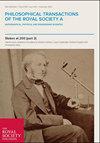A time–scale of formation of the first solids
Philosophical Transactions of the Royal Society of London. Series A, Mathematical and Physical Sciences
Pub Date : 2001-10-15
DOI:10.1098/rsta.2001.0895
引用次数: 32
Abstract
We revisit an attempt to establish a unified chronology of the first ca. 20 Myr of the Solar System in the light of recent data; this period encompasses the formation of the first solids and the earliest planetary processes. We investigate the consistency of calibrations of the chronometers based on the extinct radionuclides 26Al, 53Mn and 129I with one another and with the Pb–Pb chronometer. We find the most persuasive chronology to be that based on identifying isotopic closure of the three short–lived systems in Ste Marguerite with a common event; in effect, this modifies the calibration of the I–Xe system based on Acapulco phosphate. This can be tied, in turn, to an absolute time–scale based on the Pb–Pb and Mn–Cr ages of the angrite LEW86010. The result is a common chronology (agreement between I–Xe and Mn–Cr is particularly striking), although ages derived for calcium–aluminium–rich inclusions (CAIs) are discordant. This discordancy may be explained by nuclear effects in the CAI–formation region.第一个固体形成的时间尺度
根据最近的数据,我们重新审视了建立一个统一的太阳系第一个约20myr年表的尝试;这一时期包含了第一批固体的形成和最早的行星过程。我们研究了基于已灭放射性核素26Al、53Mn和129I的计时器彼此校准的一致性以及与Pb-Pb计时器校准的一致性。我们发现最有说服力的年代学是基于确定圣玛格丽特三个短寿命系统的同位素闭合与一个共同事件的年代学;实际上,这修改了基于Acapulco磷酸盐的I-Xe系统的校准。反过来,这可以与基于氧化铁LEW86010的Pb-Pb和Mn-Cr年龄的绝对时间尺度联系起来。结果是一个共同的年表(I-Xe和Mn-Cr之间的一致性特别引人注目),尽管富钙铝包裹体(CAIs)的年龄不一致。这种不一致可以用cai形成区的核效应来解释。
本文章由计算机程序翻译,如有差异,请以英文原文为准。
求助全文
约1分钟内获得全文
求助全文
来源期刊
自引率
0.00%
发文量
0

 求助内容:
求助内容: 应助结果提醒方式:
应助结果提醒方式:


